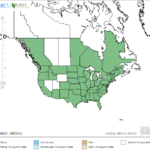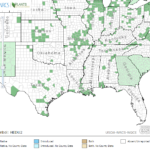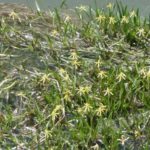Heteranthera dubia
USDA, NRCS. 2018. The PLANTS Database (http://plants.usda.gov, 28 March 2018). National Plant Data Team, Greensboro, NC 27401-4901 USA.
Illustration courtesy of University of Florida/IFAS Center for Aquatic and Invasive Plants. Used with permission.
What is Water Stargrass?
Physical Characteristics
- Submersed grass-like herb
Leaves:
- Linear or ribbon-like
- Thin
- Immobile
- Finely parallel veined
- No distinct midvein
- Up to 6 inches long
- Thin sheaths
Flowers:
- 1 flowered
- Rarely more than 0.78 inches long
- Exposed above the water
- Pale yellow in color
- Segments linear or sword-shaped, up to about 1 cm long
- 3 stamen
Seeds:
- Oblong or egg-shaped
Stem:
- Slender
- Branching
Roots:
- Branching from nodes
Where Does it Grow?
Water stargrass can be found in streams, canals, and quiet waters.
Pros and Cons of Water Stargrass
Water stargrass is consumed by ducks and wading birds, but it is not known as an important food item. Submerged portions of all aquatic plants provide habitats for many micro and macro invertebrates. These invertebrates in turn are used as food by fish and other wildlife species (e.g. amphibians, reptiles, ducks, etc.). After aquatic plants die, their decomposition by bacteria and fungi provides food (called “detritus”) for many aquatic invertebrates.






